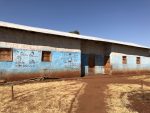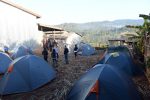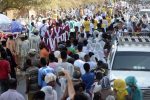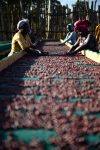
Kerchanshe Trading’s impressive export standard dry mill in Addis Ababa. Photo by Mark Shimahara/Daily Coffee News
Earlier this month, I attended the first annual Ethiopia Origin Approach expedition presented by green coffee importer Nordic Approach and its sister company, Tropiq, along with Addis-based Kerchanshe Trading.
The event brought together a small but diverse group of actors throughout the supply chain for intensive education on Ethiopian coffee, exploring numerous innovations and challenges locally, regionally and countrywide. The Guji zone of the Oromia region, where some of the world’s finest specialty coffees are produced, provided an ideal location for the experience.

Coffee is shifted around to dry uniformly and covered to prevent direct sun exposure. Photo by Mark Shimahara/Daily Coffee News
With Origin Approach partner Hortensia Solis of the Viaje Con Café, the event offered an immersive tour experience, enlightening even people who weren’t there strictly to taste and buy coffee. Yet the trip provided a range of opportunities for potential coffee buyers, too.
For Yu Wako of the small Japanese roastery Le Koppi, the trip represented a rare opportunity to travel with an importer. Other travelers, like Jean-François Leduc of Montreal’s Saint Henri, have been on many origin trips, yet this presented an opportunity to more deeply explore the recent changes of the 10-year-old Ethiopian Commodity Exchange (ECX). All guests were treated to educational sessions on the ECX, Ethiopia’s coffee grading system, a Technoserve-led water pollution initiative and much more.

A power outage didn’t stop Morten Wennersgaard, co-founder of Tropiq, lead a cupping at Kerchanshe’s Adola Washing Station lab. Photo by Mark Shimahara/Daily Coffee News
Kerchanshe Trading helped guide the group through all steps of the supply chain from the origin perspective. The organization employs more than 1,000 people while processing some 60,000 metric tons of coffee annually. It owns three farms of its own, while cherry from many more farms pass through Kerchanshe’s 36 washing stations and dry mills. The company also has an ownership hand in transportation, quality control and other infrastructure.
We visited two of Kerchanshe’s washing stations in Anasora and Adola, as well as one owned by the Sidama Cooperative. Kerchanshe’s Adola Washing Station served as the base for the expedition. Camping on the grounds provided an intimate familiarity with the processing. We slept earshot of the washing station, where we saw natural and washed coffees being processed, and parchment coffee stored. Between excursions, we took advantage of the onsite cupping lab to sample coffees. We even visited the primary school adjacent to the station, which was built by the charity founded by Israel Degfa, the owner of Kerchanshe. According to him, the school resulted from the group’s fairness of distribution policy, which involves profit-sharing with producers and numerous community-based projects.

Israel Degfa, the owner of Kerchanshe Trading, explains the milling process at his Adola Washing Station. Photo by Mark Shimahara/Daily Coffee News
The expedition provided a holistic snapshot of this slice of Ethiopia’s renowned Sidamo region, including the significant social and economic reverberations involved with coffee production and trade.
- Attendees of the First annual Ethiopian Origin Approach Expedition, at Kerchanshe’s Adola Washing Station. Photo by Mark Shimahara/Daily Coffee News
- Kerchanshe Trading’s Addis Ababa export standard dry mill. Photo by Mark Shimahara/Daily Coffee News
- The primary school built by Israel Degfa’s, charity Bunekea. It’s named after a coffee ceremony. Photo by Mark Shimahara/Daily Coffee News
- We set camp at Kerchanshe’s Adola Washing Station and used it as our primary base. Photo by Mark Shimahara/Daily Coffee News
- Yu Wako of Le Koppi receives a blessing during a Bunekea, a traditional coffee ceremony. Photo by Mark Shimahara/Daily Coffee News
- Our expedition even included us being in the middle of a procession for Timkat, the Orthodox Tewahedo celebration of Epiphany. Photo by Mark Shimahara/Daily Coffee News
- Natural coffee being dried at Kerchanshe Trading’s washing station in Anasora. Photo by Mark Shimahara/Daily Coffee News
- Coffee washing at Kerchanshe Trading’s washing station in Anasora. Photo by Mark Shimahara/Daily Coffee News
Mark Shimahara
Mark Shimahara works in online marketing and is a photographer for Roast Magazine. In 2011, Mark went to coffee growing communities in Guatemala to volunteer with Coffee Kids and the Smithsonian Migratory Bird Institute. Later that year he placed second in the World Siphonist Championships in Tokyo, Japan. In his free time he enjoys bike racing, and hitting up the coffee bars en route to his various destinations.
Comment
4 Comments
Comments are closed.














http://www.jembrcoffee.com
I wonder if the travellers were also told about the coffee blending that takes place in every dry mill in the country, and that is so badly harming the reputation of the Ethiopian coffee, where a vast majority of the coffees are not what they are supposed to be, but are mixed with lower quality coffees. Or about the refugee situation in Guji, with the biggest internal displaced population in the world, or how Sidamo farmers made an average of 9 birr per kilo of cherry this year, around 87 cts/lb of green coffee, 40% of the average FOB price for a traceable NOT MIXED coffee (210 cts)…
It’s great to bring the coffee community to the origins, but we should paint such rosy picture of the tremendously harsh situation farmers are living around the world, and specially in Southern Ethiopia.
How far could 0.87 dollar a pound go in Ethiopia. Its rough all over. That’s about what we make roasting coffee and selling it.
The next event is in Colombia in September https://originapproach.com/colombia-2019/